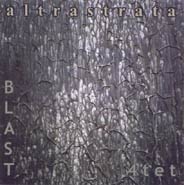
Blast 4tet
altrastrata
(ReR)
Blast
is a group from Holland with a long and fine history. We can file Blast
under "Rock In Opposition", subsection "Complicated European
Music": knotty compositional developments, a careful attention
to timbre, a rhythm section that often plays "against" the
melody. Obvious formative influences such as Henry Cow and Fred Frith
in his more "Balkanic" mode were still clearly audible in
the most recent album recorded by the group, A Sophisticated Face (1999):
an album where the group refined their aesthetics, and where the line-up
(two saxophones, guitar, bass and percussions) opened up to include
trumpet, violin, cello and marimba to further advance their musical
language; what possibilities lay ahead was the question one had to ask
oneself at the end of that record.
Altrastrata
tells a very different story. From the previous line-up here we find:
the saxophones by Dirk Bruinsma, who’s as usual very effective on soprano
and propulsive on baritone; Frank Crijns on guitar; Paed Conca on bass;
all three also play devices, electronics and electro-acoustic objects
(and no, the liner notes are not of much help in this respect). The
group appears to have decided to adopt (at least on the first four tracks
on the CD, which to me are the most successful and the newest and most
stimulating ones) quite a different attitude when it comes to the studio,
timbre, and the overdubbing process. Walking Matters, which opens the
CD, works well as an introduction, but it’s the three long pieces that
follow (H.O.I, Tectonic Re-Birth and Multi Salsa, the last with a very
good performance by guest artist Pasquale Innarella on French horn)
that bring the process to its full fruition.
The
key element to this transformation is (acoustic and electrified) drummer
and percussionist Fabrizio Spera, whose work here widens the available
options. Spera makes good use of his considerable background in the
fields of "acoustic" improvisation – hence, the multiplication
of sources, with a great deal of attention to timbre – and of "electroacoustics",
a field he explores with the group Ossatura. He’s extremely good when
acting as a "propulsive" element (obviously this is not music
which calls for a conventional "rhythm section"), but it’s
in his colouristic role that he really shines.
The
album was competently engineered by Stefano Vivaldi and intelligently
mixed by Bob Drake and the group. The mixing is excellent: it creates
very different – and extremely well-detailed – sonic planes, builds
contrasts and alters the instrumental proportions, which sometimes sound
"wrong"; this is obviously not a "photographic"
use of the studio: in this respect, this album is quite far from jazz,
and much more similar to an "evolved rock" album or to some
modern classical. (Funny thing: the CD remained quite impenetrable to
me til I turned up considerably the volume on my amplifier.)
The
fifth track, Taliba Orgena, works somewhat as a timbral transitional
point, since the last three tracks bring us back to the more usual and
(relatively speaking!) simple Blast we already know, with those electric
bass/baritone sax unisons and a relatively more conventional rhythm
section work.
Pretty
curious to see what’ll happen next, pretty curious about the way the
group will perform this material in concert. Obviously, this is not
an album to be filed under "easy", but it will surely repay
the attention that – without a doubt – it requires.
Beppe
Colli
©
Beppe Colli 2003
CloudsandClocks.net
| June 10, 2003


